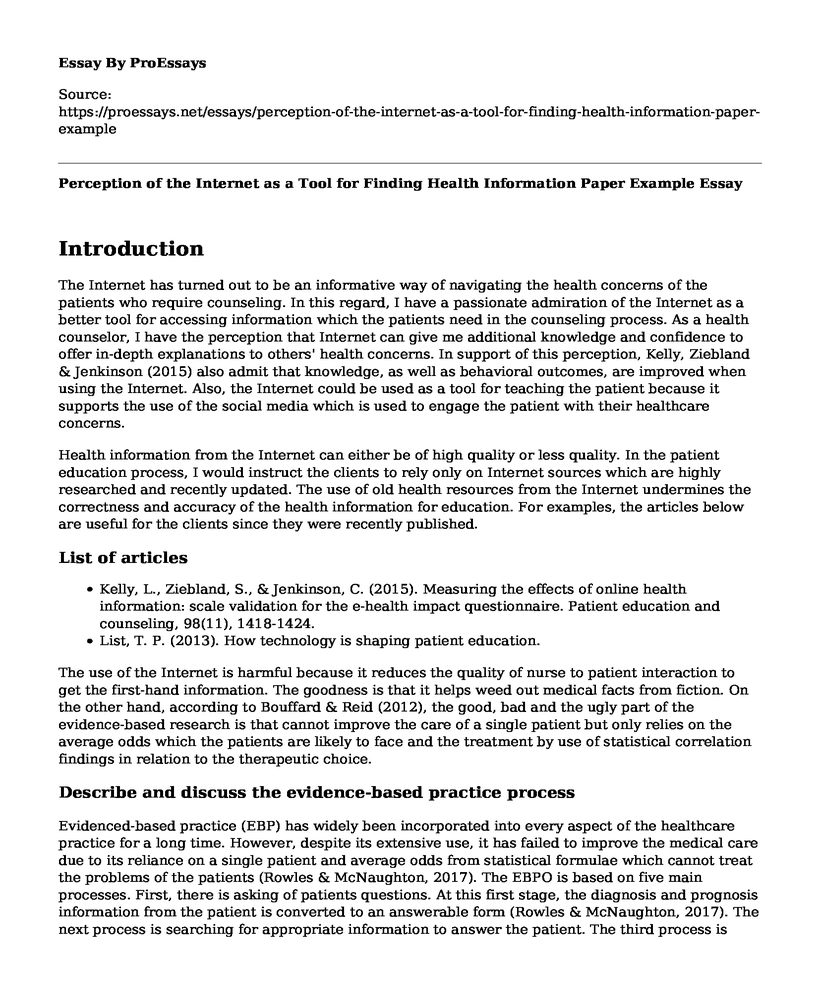Introduction
The Internet has turned out to be an informative way of navigating the health concerns of the patients who require counseling. In this regard, I have a passionate admiration of the Internet as a better tool for accessing information which the patients need in the counseling process. As a health counselor, I have the perception that Internet can give me additional knowledge and confidence to offer in-depth explanations to others' health concerns. In support of this perception, Kelly, Ziebland & Jenkinson (2015) also admit that knowledge, as well as behavioral outcomes, are improved when using the Internet. Also, the Internet could be used as a tool for teaching the patient because it supports the use of the social media which is used to engage the patient with their healthcare concerns.
Health information from the Internet can either be of high quality or less quality. In the patient education process, I would instruct the clients to rely only on Internet sources which are highly researched and recently updated. The use of old health resources from the Internet undermines the correctness and accuracy of the health information for education. For examples, the articles below are useful for the clients since they were recently published.
List of articles
- Kelly, L., Ziebland, S., & Jenkinson, C. (2015). Measuring the effects of online health information: scale validation for the e-health impact questionnaire. Patient education and counseling, 98(11), 1418-1424.
- List, T. P. (2013). How technology is shaping patient education.
The use of the Internet is harmful because it reduces the quality of nurse to patient interaction to get the first-hand information. The goodness is that it helps weed out medical facts from fiction. On the other hand, according to Bouffard & Reid (2012), the good, bad and the ugly part of the evidence-based research is that cannot improve the care of a single patient but only relies on the average odds which the patients are likely to face and the treatment by use of statistical correlation findings in relation to the therapeutic choice.
Describe and discuss the evidence-based practice process
Evidenced-based practice (EBP) has widely been incorporated into every aspect of the healthcare practice for a long time. However, despite its extensive use, it has failed to improve the medical care due to its reliance on a single patient and average odds from statistical formulae which cannot treat the problems of the patients (Rowles & McNaughton, 2017). The EBPO is based on five main processes. First, there is asking of patients questions. At this first stage, the diagnosis and prognosis information from the patient is converted to an answerable form (Rowles & McNaughton, 2017). The next process is searching for appropriate information to answer the patient. The third process is critical appraisal in which the validity, impact, and applicability of the evidence are determined, and this is useful for the clinical practice. The next step is to integrate the evaluated practices as par the patient's preferences and nurse's expertise. Finally, it is the responsibility of the nurse to assess the effectiveness as well as the efficiency of the execution of these stages.
PICO Question
In nursing, the creation of a PICO question is fundamental and cannot be avoided at all cost. The use of the PICO is useful in addressing the patient's medical problems in detail. Therefore, the formulation of such question enables the creation of a formula for tackling of several health issues of a patient. For the PICO question, each letter stands for the following:
- P- Patient Problem
- I-Intervention
- C-Comparison or Control
- O-Outcome
However, the elements of the PICO change with regards to the domain. The patient problem refers to conditions such as disease infection or any other health condition which a patient faces at any given time. The intervention implies the therapeutic measures such medication, change of lifestyle and surgical intervention which is needed as a remedy to the patient's problem. The medical response would have to be compared with the existing standard care or through another intervention with standard control measures. Lastly, the outcome is the result of the intervention and control measures. The effects can either be negative or positive for high mortality rate or high survival rates respectively.
References
Bouffard, M., & Reid, G. (2012). The Good, the Bad, and the Ugly of Evidence-Based Practice1. Adapted physical activity quarterly, 29(1), 1-24.
Kelly, L., Ziebland, S., & Jenkinson, C. (2015). Measuring the effects of online health information: scale validation for the e-health impact questionnaire. Patient education and counseling, 98(11), 1418-1424.
List, T. P. (2013). How technology is shaping patient education.
Rowles, E., & McNaughton, A. (2017). An overview of the evidence-based practice process for novice researchers. Nursing Standard (2014+), 31(43), 50.
Cite this page
Perception of the Internet as a Tool for Finding Health Information Paper Example. (2022, Jun 19). Retrieved from https://proessays.net/essays/perception-of-the-internet-as-a-tool-for-finding-health-information-paper-example
If you are the original author of this essay and no longer wish to have it published on the ProEssays website, please click below to request its removal:
- What Can Nursing Homes Do to Foster Healthy Sexual Expressions Among Residents?
- Intervention for Children With Synethesia: The Girl Who Heard Colors Essay
- Bronchopulmonary Dysplasia and Preeclampsia Paper Example
- Policy Training Plan Paper Example
- Elderly Health Care: Examining Its Impact on Life Satisfaction - Essay Sample
- Rising Diabetes: Treatment Needed to Prevent Complications & Death - Research Paper
- Essay Example on Depression is a Disease: Aggressive Treatment Needed to Avoid Prolonged Suffering







